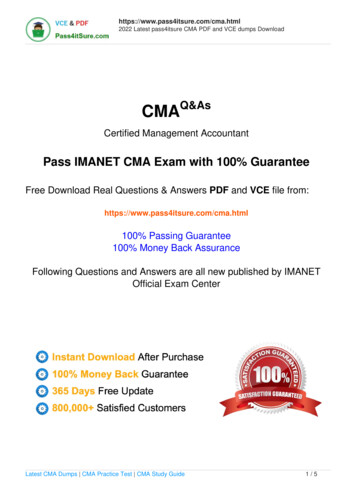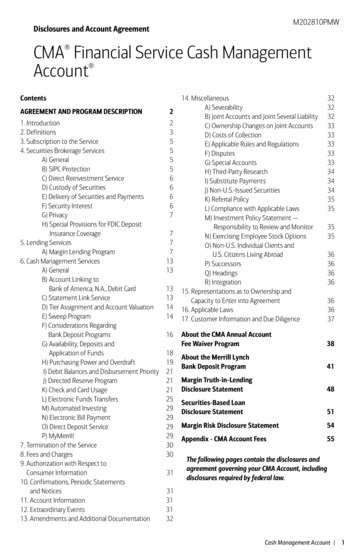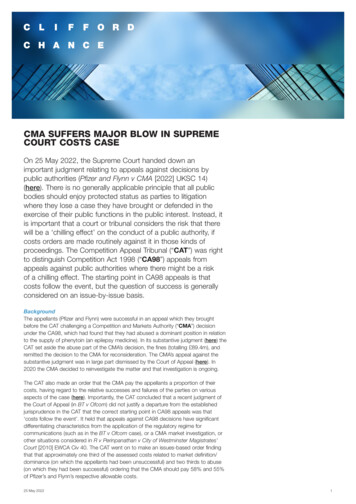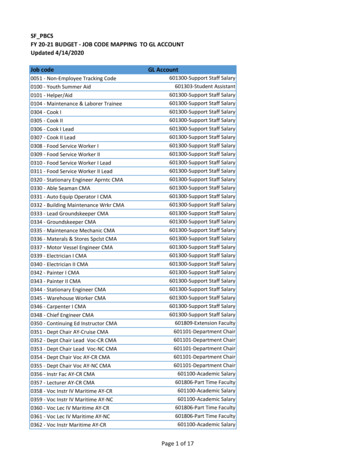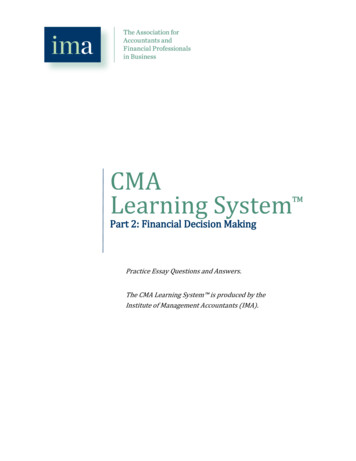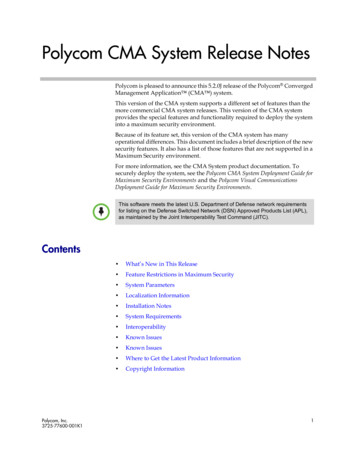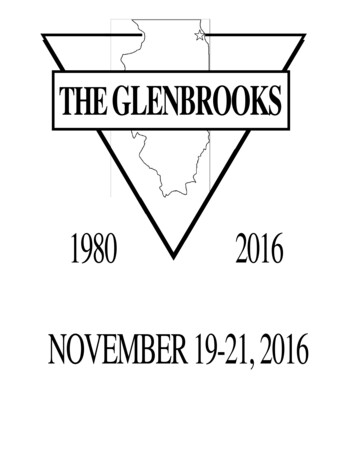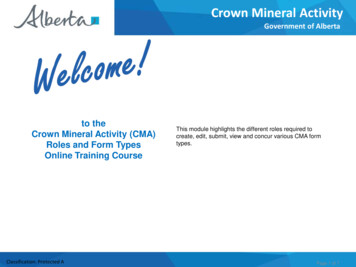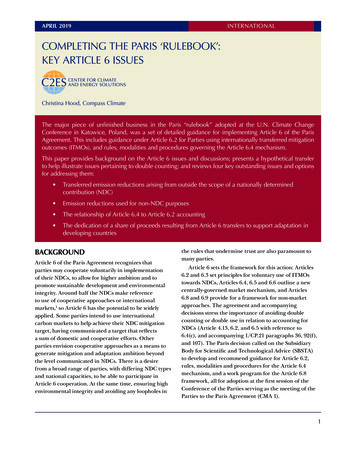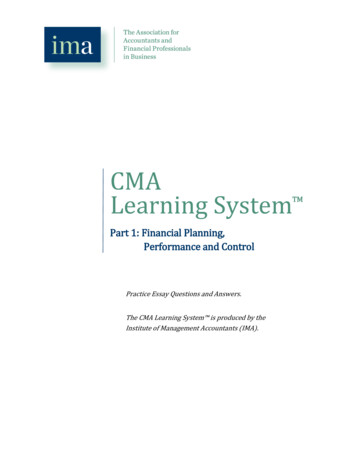
Transcription
CMALearning SystemTMPart 1: Financial Planning,Performance and ControlPractice Essay Questions and Answers.The CMA Learning System is produced by theInstitute of Management Accountants (IMA).
Practice Essay Questions copyright 2009 Institute of Management AccountantsThese materials are copyrighted and may not be reproduced in any form or used in any way tocreate derivative works. Any reproduction, reuse, or distribution of CMA Learning System materials without prior written permission from the Institute of Management Accountants (IMA) isillegal and a material violation of the IMA Statement of Ethical Professional Practice.Any Certified Management Accountant (CMA) or CMA candidate who reproduces, reuses, ordistributes CMA Learning System materials or content in any form without prior authorization fromIMA is subject to legal action and will be reported to the Institute of Certified ManagementAccountants (ICMA) and immediately expelled from the IMA and CMA program.It is your responsibility to ensure that any CMA exam review materials that you are using have beenprovided to you through authorized channels or personnel. If you are in doubt about theauthenticity of your materials or question the means by which they have been provided to you,contact IMA customer service at (800) 638-4427 in the U.S. or 1 (201) 573-9000.This material is designed for learning purposes and is distributed with the understanding that thepublisher and authors are not offering legal or professional services.CMALS Part 1: Financial Planning, Performance and Control, Version 3.0 2009 Institute of Management Accountants. All rights reserved.2
Practice Essay QuestionsThe Institute of Management AccountantsCMA Learning System Part 1: Financial Planning, Performance and ControlEssay QuestionsPractice Essay Questions (Section A to E) . 4Practice Essay Question Answers .25CMALS Part 1: Financial Planning, Performance and Control, Version 3.0 2009 Institute of Management Accountants. All rights reserved.3
Practice Essay QuestionsPractice Essay QuestionsThe following essay questions, and the answers that appear at the end,were adapted from the Revised CMA exam, Questions and Answers:Part 4 (2005 and 2008) books supplied by the Institute of CertifiedManagement Accountants and are used with their permission.The focus of the questions will be on the test taker’s ability to applyconcepts presented in the part being tested to a business scenario.The answers supplied are meant to serve as samples of answers thataddress 80% or more of the points listed on the question grading guide.There are generally more points on the grading guide than points thatcan be awarded (i.e., there may be 110 possible points but only 100 thatcan be awarded in total), so answers scoring 80% may vary among testtakers. Thus, the answers presented here represent one possibleanswer, not a definitive correct answer.Part 1 Section A QuestionsQuestion 1A-ES01Rein Company, a compressor manufacturer, is developing a budgeted incomestatement for the calendar year 2006. The president is generally satisfied withthe projected net income for 2005 of 700,000 resulting in an earnings pershare figure of 2.80. However, next year he would like earnings per share toincrease to at least 3. Rein Company employs a standard absorption costsystem. Inflation necessitates an annual revision in the standards as evidencedby an increase in production costs expected in 2006. The total standardmanufacturing cost for 2005 is 72 per unit produced.Rein expects to sell 100,000 compressors at 110 each in the current year(2005). Forecasts from the sales department are favorable, and Rein Companyis projecting an annual increase of 10% in unit sales in 2006 and 2007. Thisincrease in sales will occur even though a 15 increase in unit selling price willbe implemented in 2006. The selling price increase was absolutely essential tocompensate for the increased production costs and operating expenses.However, management is concerned that any additional sales price increasewould curtail the desired growth in volume.Standard production costs are developed for the two primary metals used inthe compressor (brass and a steel alloy), the direct labor, and manufacturingoverhead. The following schedule represents the 2006 standard quantitiesand rates for material and labor to produce one compressor.Brass4 pounds@CMALS Part 1: Financial Planning, Performance and Control, Version 3.0 2009 Institute of Management Accountants. All rights reserved. 5.35/pound 21.404
Practice Essay QuestionsSteel alloyDirect labor5 pounds@ 3.16/pound15.804 hours@ 7.00/hour28.00Total prime costs 65.20The material content of the compressor has been reduced slightly, hopefullywithout a noticeable decrease in the quality of the finished product. Improvedlabor productivity and some increase in automation have resulted in adecrease in labor hours per unit from 4.4 to 4.0. However, the significantincreases in material prices and hourly labor rates more than offset anysavings from reduced input quantities. The manufacturing overhead cost perunit schedule has yet to be completed. Preliminary data is as follows:Activity Level (units)100,000110,000120,000 475,000 522,000 570,000Indirect 87,000421,000421,000421,000 2,046,000 2,178,000 2,310,000Overhead itemsSuppliesTaxes and insuranceDepreciationTotal overheadThe standard overhead rate is based upon direct labor hours and is developedby using the total overhead costs from the above schedule for the activity levelclosest to planned production. In developing the standards for themanufacturing costs the following two assumptions were made. The cost of brass is currently selling at 5.65/pound. However, this price ishistorically high and the purchasing manager expects the price to drop tothe predetermined standard early in 2006. Several new employees will be hired for the production line in 2006. Theemployees will be generally unskilled. If basic training programs are noteffective and improved labor productivity is not experienced, then theproduction time per unit of product will increase by 15 minutes over the2006 standards.Rein employs a LIFO inventory system for its finished goods. Rein’s inventorypolicy for finished goods is to have 15% of the expected annual unit sales forthe coming year in finished goods inventory at the end of the prior year. Thefinished goods inventory at December 31, 2005, is expected to consist of16,500 units at a total carrying cost of 1,006,500.Operating expenses are classified as selling, which are variable, andadministrative, which are all fixed. The budgeted selling expenses areCMALS Part 1: Financial Planning, Performance and Control, Version 3.0 2009 Institute of Management Accountants. All rights reserved.5
Practice Essay Questionsexpected to average 12% of sales revenue in 2006 which is consistent with theperformance in 2005. The administrative expenses in 2006 are expected to be20% higher than the predicted 2005 amount of 907,850.Management accepts the cost standards developed by the production andaccounting department. However, they are concerned about the possible effecton net income if the price of brass does not decrease, and/or the laborefficiency does not improve as expected. Therefore management wants thebudgeted income statement to be prepared using the standards as developedbut to consider the worst possible situation for 2006. Each resultingmanufacturing variance should be separately identified and added to orsubtracted from budgeted cost of goods sold at standard. Rein is subject to a45% income tax rate.QuestionsA. Prepare the budgeted income statement for 2006 for Rein Company asspecified by management. Round all calculations to the nearest dollar.B. Review the 2006 budgeted income statement prepared for Rein Companyand discuss whether the president’s objectives can be achieved.Question 1A-ES02Gleason Company, a manufacturer of children's toys and furniture, isbeginning budget preparation for next year. Jack Tiger, a recent addition to theaccounting staff at Gleason, is questioning Leslie Robbins and James Crowe,sales and production managers, to learn about Gleason's budget process.Crowe says that he incorporates Robbins's sales projections when estimatingclosing inventories, but that the resulting numbers aren't completely reliablebecause Robbins makes some "adjustments" to her projections. Robbinsadmits that she does, indeed, lower initial sales projections by 5% to 10% togive her department some breathing room. Crowe admits that his departmentmakes adjustments not unlike Robbins's; specifically, production adds about10% to its estimates. "I think everyone here does something similar," he says,and Robbins nods assent.QuestionsA. What benefits do Robbins and Crowe expect to realize from their budgetarypractices?B. What are possible adverse effects of introducing budgetary slack forRobbins and Crowe?CMALS Part 1: Financial Planning, Performance and Control, Version 3.0 2009 Institute of Management Accountants. All rights reserved.6
Practice Essay QuestionsQuestion 1A-ES03Eugene Logan is the chief financial officer of Artech Corporation, amanufacturer and distributor of electronic security devices primarily suitedfor residential applications. Logan is currently in the process of preparing nextyear's annual budget and implementing an incentive plan to reward theperformance of key personnel. The final operating plans will then bepresented to the Board of Directors for approval.Logan is aware that next year may be difficult due to announced priceincreases to major customers. Artech's president has put pressure onmanagement to achieve the current year's earnings per share amounts. Loganis, therefore, considering introducing zero-based budgeting in order to bringcosts into line with revenue expectations.Leonard Drake, Artech's manufacturing director, is attempting to convinceLogan to build "budgetary slack" into the operating budget. Drake contendsthat productivity is burdened by an abnormal amount of product designchanges and small lot size production orders that incur costly set-up times.QuestionsA. Explain at least three advantages and at least three disadvantages ofbudgetary slack from the point of view of Artech Corporation's managementgroup as a whole.B. Describe how zero-based budgeting could be advantageous to ArtechCorporation's overall budget process.Question 1A-ES04Matchpoint Racquet Club (MRC) is a sports facility that offers tennis, racquetball, and other physical fitness facilities to its members. MRC owns andoperates a large club with 2,000 members in a metropolitan area. The club hasexperienced cash flow problems over the last five years, especially during thesummer months when both court use and new membership sales are low.Temporary bank loans have been obtained to cover the summer shortages.The owners have decided to take action to improve MRC’s net cash flowposition. They have asked the club’s financial manager to prepare a projectedcash budget based on a proposed revised fee structure. The proposal wouldincrease membership fees and replace the hourly tennis and racquet ball courtfees with a quarterly charge that would allow unlimited usage of the courts.The new rates would remain competitive when compared to the rates of otherclubs in the area. Although there will be some members who do not renewbecause of the increase in price, management believes that the offer ofunlimited court time will increase membership by 10%.CMALS Part 1: Financial Planning, Performance and Control, Version 3.0 2009 Institute of Management Accountants. All rights reserved.7
Practice Essay QuestionsThe proposed fee structure is shown below, along with the currentmembership distribution. The membership distribution is assumed to remainunchanged. All members would be required to pay the quarterly courtcharges.Proposed Fee StructureMembership CategoryAnnual Membership FeesQuarterly Court ChargesIndividual 300 50Student 180 40Family 600 90Membership ted Membership Payment ActivityCourt Time in The average membership during the third quarter is projected to be 2,200people. Fixed costs are 157,500 per quarter, including a quarterlydepreciation charge of 24,500. Variable costs are estimated at 15 per hourof total court usage time.QuestionsA. Prepare MRC’s cash budget for the third quarter. Assume the opening cashbalance is 186,000, that membership at the beginning of the quarter is 2,000,and that the change to the new pricing structure will be implemented. Includesupporting calculations where appropriate.B. How would sensitivity analysis help MRC management in the decisionmaking process?C. Identify at least four factors that MRC should consider before implementingthis decision.CMALS Part 1: Financial Planning, Performance and Control, Version 3.0 2009 Institute of Management Accountants. All rights reserved.8
Practice Essay QuestionsPart 1 Section B QuestionsQuestion 1B-ES01Handler Company distributes two power tools to hardware stores—a heavyduty ½ inch hand drill and a table saw. The tools are purchased from amanufacturer where the Handler private label is attached. The wholesaleselling prices to the hardware stores are 60 each for the drill and 120 eachfor the table saw. The 2005 budget and actual results are presented below.The budget was adopted in late 2004 and was based upon Handler’s estimatedshare of the market for the two tools.Handler Company Income Statementfor the Year Ended December 31, 2005(000s omitted)Hand DrillTable ce12086807420016040 7,200 5,074 9,600 8,510 16,800 13,584 (3,216)6,0004,3006,4006,06812,40010,3682,032 1,200 774 3,200 g1,0001,060(60)400406(6)Sales in UnitsRevenueCost of goods soldGross MarginUnallocated costsAdministrationIncome Taxes (45%)Total unallocated costsNet income9003385623,3002,804496 1,100 412 (688)During the first quarter of 2005, Handler’s management estimated that thetotal market for these tools would actually be 10% below its originalestimates. In an attempt to prevent Handler’s unit sales from declining asmuch as industry projections, management developed and implemented amarketing program. Included in the program were dealer discounts andincreased direct advertising. The table saw line was emphasized in thisprogram.QuestionsA. Analyze the unfavorable gross margin variance of 1,184,000 in terms of:1. sales price variance2. cost variance3. volume varianceCMALS Part 1: Financial Planning, Performance and Control, Version 3.0 2009 Institute of Management Accountants. All rights reserved.9
Practice Essay QuestionsB. Discuss the apparent effect of Handler Company’s special marketingprogram (i.e., dealer discounts and additional advertising) on 2005 operatingresults. Support your comments with numerical data where appropriate.Question 1B-ES02The Jackson Corporation is a large, manufacturing company where eachdivision is viewed as an investment center and has virtually completeautonomy for product development, marketing and production. Performanceof division managers is evaluated periodically by senior corporatemanagement. Divisional return on investment is the sole criterion used inperformance evaluation under current corporate policy. Corporatemanagement believes return on investment is an adequate measure because itincorporates quantitative information from the divisional income statementand balance sheet in the analysis.Some division managers complained that a single criterion for performanceevaluation is insufficient and ineffective. These managers have compiled a listof criteria which they believe should be used in evaluating division managers’performance. The criteria include profitability, market position, productivity,product leadership, employee development, employee attitudes, publicresponsibility, and balance between short-range and long-range goals.QuestionsA. Jackson management believes that return on investment is an adequatecriterion to evaluate division management performance. Discuss theshortcomings or possible inconsistencies of using return on investment as thesole criterion to evaluate divisional management performance.B. Discuss the advantages of using multiple criteria versus a single criterion toevaluate divisional management performance.C. Describe the problems or disadvantages which can be associated with theimplementation of the multiple performance criteria measurement systemsuggested to Jackson Corporation by its division managers.Question 1B-ES03George Nickles has recently been appointed vice president of operations forMerriam Corporation. The company's business segments include manufactureof heavy equipment, food processing, and financial services. Nickles hassuggested to Merriam's chief financial officer, Karen Schilling, that segmentmanagers should be evaluated on segment data contained in the company'sannual report, which presents revenues, earnings, identifiable assets, anddepreciation for each segment for a five-year period. Nickles reasons thatsegment managers may be appropriately evaluated by the same criteria usedCMALS Part 1: Financial Planning, Performance and Control, Version 3.0 2009 Institute of Management Accountants. All rights reserved.10
Practice Essay Questionsto evaluate top management. Schilling has doubts about using informationfrom the annual report for that purpose and suggests that Nickles considerother ways of evaluating the segment managers.QuestionsA. What legitimate concerns might Karen Schilling have regarding theevaluation of segment managers using segment information prepared forpublic reporting?B. What could the possible behavioral impact be on Merriam Corporation'ssegment managers if their performance evaluations are based on informationpublished in the annual report?C. What types of financial information would be more appropriate for GeorgeNickles to use in evaluating the performance of segment managers?Question 1B-ES04ARQ Enterprises was formed by the merger of Andersen, Rolvaag, and QuieCorporations. Its three divisions retain the names of the former companiesand operate with complete autonomy. Corporate management evaluates thedivisions and division management according to return on investment.The Rolvaag and Quie divisions are currently negotiating a transfer price for acomponent that Quie manufactures and Rolvaag needs. Quie, which sells thecomponent already into a market that it expects to grow rapidly, currently hasexcess capacity. Rolvaag could buy the component from other suppliers.Three transfer prices are under consideration: Rolvaag has bid 3.84 for the component, which is Quie's standard variablemanufacturing cost plus a 20% markup. Quie has offered the component to Rolvaag at 5.90, which is its regularselling price in the marketplace ( 6.50) minus variable selling anddistribution expenses. ARQ management, which has no established policy on transfer pricing, hasoffered the compromise price of 5.06, which is the standard fullmanufacturing cost plus 15%.Both the Quie and Rolvaag divisions have rejected the compromise price.Refer to the pricing chart for a summary of this informationCMALS Part 1: Financial Planning, Performance and Control, Version 3.0 2009 Institute of Management Accountants. All rights reserved.11
Practice Essay QuestionsPricing ChartRegular selling priceStandard variable manufacturing costStandard full manufacturing costVariable selling and distribution expenses 6.50 3.20 4.40 0.60Standard variable manufacturing cost plus20% ( 3.20 x 1.20) 3.84Regular selling price less variable selling and distributionexpenses ( 6.50- 0.6) 5.90Standard full manufacturing cost plus15% ( 4.40 x 1.15) 5.06QuestionsA. What effect might each of the three proposed prices have on the Quiedivision management's attitude toward intracompany business?B. Would a negotiation of a price between Quie and Rolvaag be a satisfactorymethod to establish a transfer price in this situation? Explain your decision.C. Should ARQ corporate management become involved in resolving thistransfer price controversy? Explain your decision.Question 1B-ES05Within Sparta Enterprises, the extraction division transfers 100% of its totaloutput of 500,000 units of a particular type of clay to the pet productsdivision, which treats the clay and sells it as cat litter for 42 a unit. The petproducts division currently pays a transfer price for the clay of cost plus 10%,or 22 a unit. The clay has many other uses and could be sold in themarketplace for 26 in virtually unlimited quantities. If the extraction divisiondid sell the clay into the wider market, it would incur a variable selling cost of 1.50 per unit.The extraction division recently hired a new manager, Keith Richardson, whoimmediately complained to top management about the disparity between thetransfer price and the market price. For the most recent year, the pet productsdivision's contribution margin on the sale of 500,000 units of cat litter was 5,775,000. The extraction unit's contribution margin on the transfer of anequal number of units of clay to the pet products division was 1,625,000.Refer to the Unit Cost Structure chart for more information.CMALS Part 1: Financial Planning, Performance and Control, Version 3.0 2009 Institute of Management Accountants. All rights reserved.12
Practice Essay QuestionsUnit Cost StructureExtractionDivisionPet ProductsDivisionTransfer price for clayMaterial costLabor costOverhead— 4611* 22247**Total cost per unit 20 35*Overhead in the extraction division is 25% fixed and 75% variable.**Overhead in the per products division is 65% fixed and 35% variable.QuestionsA. Why don't cost-based transfer prices provide an appropriate measure ofdivisional performance?B. Using the market price for the clay, what is the contribution margin for thetwo divisions for the most recent year?C. What price range for the clay would be acceptable to both divisions if Spartainstituted negotiated transfer pricing and allowed the divisions to buy and sellclay on the open market? Explain your answer.D. Why should a negotiated transfer price result in desirable behavior fromthe management of the two divisions?Question 1B-ES064-Cycle, Inc., manufactures small engines for recreational vehicles,motorcycles, boats, and stationary equipment. Each line has its own productmanager. The company CFO, Stan Downs, prepares divisional budgets on aper-month basis using a standard cost system. Each product line occupies itsown space, with square footage varying considerably among lines. Fixedproduction costs are allocated on the basis of square feet using a factory-widerate. Variable factory overhead is based on machine hours. Other costs arebased on revenue.At the company's quarterly meeting, Laura Fleur, the new product managerfor marine engines, received an unpleasant surprise. When distributing theperformance report (see below) to each manager, Stan Downs remarkedaloud that Fleur would need to see him after the meeting to discuss ways toimprove her line's lackluster performance. Since she thought her firstquarter's performance was impressive, she was taken aback by Downs'CMALS Part 1: Financial Planning, Performance and Control, Version 3.0 2009 Institute of Management Accountants. All rights reserved.13
Practice Essay Questionscomments. The performance report (see background information) providedher with no clue to what had gone wrong.Performance Report4-Cycle, Inc.Marine Engine Quarterly Performance ReportActualUnits10,500Revenue17,500,000Variable production costsDirect materials2,500,000Direct labor2,193,000Machine time2,300,000Factory overhead4,500,000Fixed production costsIndirect ce437,000Administrative expense1,226,000Marketing expense848,000Research and development613,000Operating profit 1,225,000BudgetVariance8,50014,700,0002,000 F2,800,000 F2,164,7501,790,0001,950,0003,825,000335,250 U403,000 U350,000 U675,500 U580,250500,000220,000437,000919,500540,000460,000 1,313,500344,750 U—12,500 U—306,500 U308,000 U153,000 U 88,500 UQuestionsA. What are at least three weaknesses in 4-Cycle's quarterly performancereport? Explain your answer.B. What are some ways in which 4-Cycle can eliminate the weaknesses in theway it reports quarterly performance to its managers? Revise the quarterlyreport accordingly.CMALS Part 1: Financial Planning, Performance and Control, Version 3.0 2009 Institute of Management Accountants. All rights reserved.14
Practice Essay QuestionsPart 1 Section C QuestionsQuestion 1C-ES01Many companies recognize that their cost systems are inadequate for today’spowerful global competition. Managers in companies selling multiple productsare making important product decisions based on distorted cost information,as most cost systems designed in the past focused on inventory valuation. Inorder to elevate the level of management information, it has been suggestedthat companies should have as many as three cost systems for (1) inventoryvaluation, (2) management control of operations, and (3) an activity-basedcosting system for decision-making.QuestionsA. Discuss why the traditional cost system, developed to value inventory,distorts product cost information.B. 1. Describe the benefits that management can expect from activity-basedcosting.to2. List the steps that a company, using a traditional cost system, would takeimplement activity-based costing.Question 1C-ES02TruJeans, a new startup company, plans to produce blue jean pants,customized with the buyer's first name stitched across the back pocket. Theproduct will be marketed exclusively via an internet website. For the comingyear, sales have been projected at three different levels: optimistic, neutral,and pessimistic. TruJeans does keep inventory on hand, but prefers tominimize this investment.The controller is preparing to assemble the budget for the coming year, and isunsure about a number of issues, including the following. The level of sales to enter into the budget. How to allocate the significant fixed costs to individual units. Whether to use job order costing or process costing.In addition, the controller has heard of kaizen budgeting and is wondering ifsuch an approach could be used by TruJeans.QuestionsA. How could the use of variable (direct) costing mitigate the problem of howto allocate the fixed costs to individual units?CMALS Part 1: Financial Planning, Performance and Control, Version 3.0 2009 Institute of Management Accountants. All rights reserved.15
Practice Essay QuestionsB. Which cost system seems to make more sense for TruJeans, job ordercosting or process costing? Explain your answer.CMALS Part 1: Financial Planning, Performance and Control, Version 3.0 2009 Institute of Management Accountants. All rights reserved.16
Practice Essay QuestionsPart 1 Section D QuestionsQuestion 1D-ES01Superior Co. manufactures automobile parts for sale to major automakers.Superior’s internal audit staff is reviewing the internal controls overmachinery and equipment and making recommendations for improvementswhere appropriate.The internal auditors obtained the information presented below during thisreview. Purchase requests for machinery and equipment are normally initiated bythe supervisor in need of the asset. The supervisor discusses the proposedacquisition with the plant manager. A purchase requisition is submitted tothe purchasing department when the plant manager determines that therequest is reasonable and that there is a remaining balance in the plant’sshare of the total corporate budget for capital acquisitions. Upon receiving a purchase requisition for machinery or equipment, thepurchasing department manager looks through the records for anappropriate supplier. A formal purchase order is then completed and mailed.When the machine or equipment is received, it is immediately sent to theuser department for installation. This allows the economic benefits from theacquisition to be realized at the earliest possible date. The property, plant, and equipment ledger control accounts are supportedby lapsing schedules organized by year of acquisition. These lapsingschedules are used to compute depreciation as a unit for all assets of a giventype that are acquired in the same year. Standard rates, depreciationmethods, and salvage values are used for each major type of fixed asset.These rates, methods, and salvage values were set ten years ago during thecompany’s initial year of operation. When machinery or equipment is retired, the plant manager notifies theaccounting department so that the appropriate entries can be made in theaccounting records. There has been no reconciliation since the company began operationsbetween the accounting records and the machinery and equipment on-hand.QuestionsIdentify the internal control weaknesses and recommend improvements thatthe internal audit staff of Superior Co. should include in its report regardingthe internal controls employed for fixed assets. Use the following format inpreparing your answer.WeaknessesCMALS Part 1: Financial Planning, Performance and Control, Version 3.0 2009 Institute of Management Accountants. All rights reserved.Recommendations17
Practice Essay Questions1.1.Question 1D-ES02The Board of Directors of a Large Corporation recently learned that som
were adapted from the Revised CMA exam, Questions and Answers: Part 4 (2005 and 2008) books supplied by the Institute of Certified Management Accountants and are used with their permission. The focus of the questions will be on the test taker's ability to apply concepts presented in the part being tested to a business scenario.
